Its origin is all the more difficult to determine as the event lasts on the order of a thousandth of a second.
Astrophysicists have identified for the first time a magnetar in our galaxy as the source of a "rapid radio burst", according to several studies published Wednesday.
Since the first detection of this cosmic phenomenon in 2007, scientists have been wondering about the explanation of these flashes of electromagnetic waves or FRB (Fast Radio Burst).
From the most serious assumptions, like the phenomenon of evaporation from a black hole, to the more exotic, like an extraterrestrial signal.
Until now, it was believed that these could only come from other galaxies.
The most precise previous detection, dating back to 2016, pointed to a dwarf galaxy located more than three billion light years from Earth.
Magnetar, contraction of "magnetic star"
On April 28, a Canadian experiment, CHIME, and the American STARE2 observatory detected such a burst.
The two teams attributed it to the SGR 1935 + 2154 magnetar, located in our Milky Way, according to their respective studies published in Nature.
“This is the first rapid radio burst attributed to a known object,” says Christopher Bochenek, astrophysicist at the American Caltech Institute and responsible for STARE2.
And what an object.
"The magnetar (contraction of" magnetic star ") is a kind of neutron star with a magnetic field so powerful that it deforms the nucleus of an atom into a pencil," he explained in a press briefing.
The small body, of the order of ten kilometers, but of significant mass, - a teaspoon of matter would weigh several billion tons -, turns on itself in a time of the order of a few seconds.
30,000 light years
The detected FRB emitted, "in one millisecond as much radio wave energy as the sun for 30 seconds," according to Christopher Bochenek.
A signal strong enough to find traces in the receiver of a smartphone after it has crossed half of the galaxy.
A journey estimated at 30,000 light years.
The discovery is the result of a real international effort, with the Canadian telescope of a new type CHIME and the small West American network of STARE2 radio listening stations, - dedicated to the detection of radio bursts in our galaxy -, and the Chinese FAST radio telescope.
Newsletter - Most of the news
Every morning, the news seen by Le Parisien
I'm registering
Your email address is collected by Le Parisien to enable you to receive our news and commercial offers.
Learn more
The latter's data, used in the third study, conducted by Prof. Bing Zhang of the University of Las Vegas, helped "determine how magnetars are associated with FRBs."
But also to understand a little better how they work.

